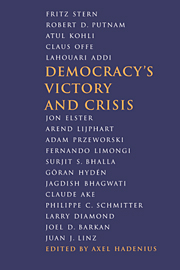Book contents
- Frontmatter
- Contents
- List of contributors
- Acknowledgments
- 1 Victory and crisis: introduction
- Part 1 Historical perspectives
- Part 2 Social and cultural aspects
- Part 3 Constitutional questions
- 7 Ways of constitution-making
- 8 Back to democratic basics: who really practices majority rule?
- Part 4 Democracy and development
- Part 5 Democracy and globalization
- Part 6 Promoting democracy
- Index
7 - Ways of constitution-making
Published online by Cambridge University Press: 13 October 2009
- Frontmatter
- Contents
- List of contributors
- Acknowledgments
- 1 Victory and crisis: introduction
- Part 1 Historical perspectives
- Part 2 Social and cultural aspects
- Part 3 Constitutional questions
- 7 Ways of constitution-making
- 8 Back to democratic basics: who really practices majority rule?
- Part 4 Democracy and development
- Part 5 Democracy and globalization
- Part 6 Promoting democracy
- Index
Summary
Introduction
The topic of this chapter is how new constitutions are made, the mechanics of constitution-making. Surprisingly, there is no body of literature that deals with the constitution-making process in a positive, explanatory perspective. There are, to be sure, a number of studies, on which I shall draw heavily, of particular constitution-making episodes. There is a large comparative and theoretical literature on the ordinary legislative process. There is a substantial body of writings on comparative constitutional law. Much has also been written on normative issues of optimal constitutional design – presidential versus parliamentary systems, unicameralism versus bicameralism, and so on. But there is not, to my knowledge, a single book or even article that considers the process of constitution-making, in its full generality, as a distinctive object of positive analysis. Here, I take a few steps towards remedying that deficiency.
I shall proceed as follows. In Section II, I discuss various ways of defining the constitution and the relation among them. In Section III, I survey various modes of constitution-making, from Lycurgus to the present. In Section IV, I discuss the psychology of constitution-makers. I conclude in Section V by discussing some normative aspects of the constitution-making process.
Defining the constitution
Constitutions can be written or unwritten. Some countries that do have a written constitution also operate through unwritten “constitutional conventions” (Marshall 1986). In the United States, for instance, the independence of the Central Bank (i.e., the Federal Reserve Board) is not explicitly stated in the constitution, as it is in some other countries.
- Type
- Chapter
- Information
- Democracy's Victory and Crisis , pp. 123 - 142Publisher: Cambridge University PressPrint publication year: 1997
- 19
- Cited by



